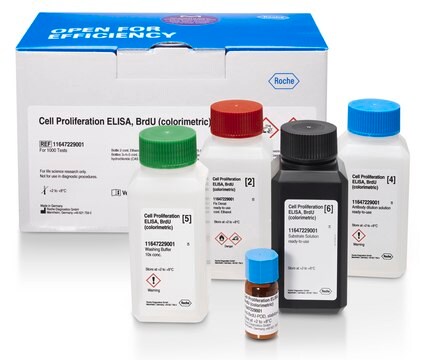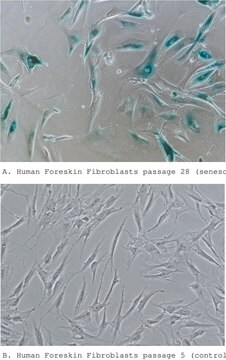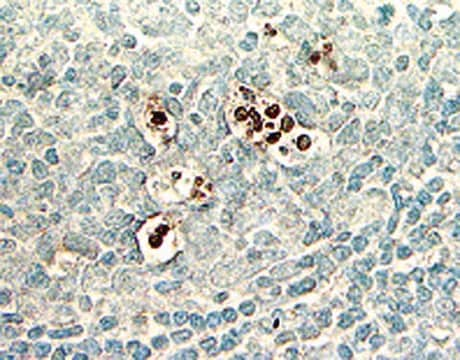11544675001
Roche
Cell Death Detection ELISA
sufficient for ≤96 tests, suitable for ELISA, kit of 1 (9 components)
Sinônimo(s):
ELISA
Faça loginpara ver os preços organizacionais e de contrato
About This Item
Código UNSPSC:
41116158
Produtos recomendados
uso
sufficient for ≤96 tests
Nível de qualidade
embalagem
kit of 1 (9 components)
fabricante/nome comercial
Roche
técnica(s)
ELISA: suitable
temperatura de armazenamento
2-8°C
Descrição geral
The Cell Death Detection ELISA serves as photometric enzyme immunoassay for the qualitative and quantitative in vitro determination of cytoplasmic histone-associated DNA fragments (mono- and oligonucleosomes) after induced cell death. This assay is based on the quantitative sandwich-enzyme immunoassay-principle using mouse monoclonal antibodies directed against DNA and histones, respectively. The antibodies used are not species specific.
Especificidade
Anti-histone antibody reacts with the histones H1, H2A, H2B, H3, and H4 of various species (e.g., human, mouse, rat, hamster, cow, opossum, and Xenopus). Anti-DNA-POD antibody binds to ss- and dsDNA. Therefore, the ELISA allows the detection of mono- and oligonucleosomes from various species, and may be applied to measure apoptotic cell death in many different cell systems.
Aplicação
Cell Death Detection ELISA has been used to measure Caspase-3 activity, intracellular reactive oxygen species (ROS) and cell apoptosis.
For research use only. Not for use in diagnostic procedures.
Specific determination of mono- and oligonucleosomes in the cytoplasmic fraction of cell lysates.
Specific determination of mono- and oligonucleosomes in the cytoplasmic fraction of cell lysates.
Embalagem
1 kit containing 9 components.
Nota de preparo
Working solution: Coating solution
Predilute 1 ml Coating buffer conc. with 9 ml double dist. water. Shortly before use, dilute 1 ml anti-histone antibody (reconstituted) with 9 ml Coating buffer.
Washing solution
Warm the Washing buffer concentrate to 15 to 25 °C and dilute 40 ml in 360 ml double distilled water. Mix thoroughly.
Sample solution
Preparation of the sample solution depends on the cell system used and the extent of cell death.
Example: Dilute 25 μl of sample in 225 μl Incubation buffer.
Conjugate solution
Dilute 1 ml Anti-DNA-POD (reconstituted) with 9 ml Incubation buffer.
Substrate solution
Depending on the number of samples tested, dissolve 1, 2, or 3 tablets in 5, 10, or 15 ml Substrate buffer.
Allow to come to 15 to 25 °C before use.
Note: The ABTS solution is light sensitive over extended periods of time.
Storage conditions (working solution): Anti-histone
2 to 8 °C for 2 months
Anti-DNA-POD
2 to 8 °C for 2 months
Coating solution
Prepare immediately before use!
Washing solution
2 to 8 °C for 2 months
Sample solution
2 to 8 °C for 2 months
Conjugate solution
Prepare immediately before use!
Substrate solution
2 to 8 °C for 1 month, protected from light.
Predilute 1 ml Coating buffer conc. with 9 ml double dist. water. Shortly before use, dilute 1 ml anti-histone antibody (reconstituted) with 9 ml Coating buffer.
Washing solution
Warm the Washing buffer concentrate to 15 to 25 °C and dilute 40 ml in 360 ml double distilled water. Mix thoroughly.
Sample solution
Preparation of the sample solution depends on the cell system used and the extent of cell death.
Example: Dilute 25 μl of sample in 225 μl Incubation buffer.
Conjugate solution
Dilute 1 ml Anti-DNA-POD (reconstituted) with 9 ml Incubation buffer.
Substrate solution
Depending on the number of samples tested, dissolve 1, 2, or 3 tablets in 5, 10, or 15 ml Substrate buffer.
Allow to come to 15 to 25 °C before use.
Note: The ABTS solution is light sensitive over extended periods of time.
Storage conditions (working solution): Anti-histone
2 to 8 °C for 2 months
Anti-DNA-POD
2 to 8 °C for 2 months
Coating solution
Prepare immediately before use!
Washing solution
2 to 8 °C for 2 months
Sample solution
2 to 8 °C for 2 months
Conjugate solution
Prepare immediately before use!
Substrate solution
2 to 8 °C for 1 month, protected from light.
Reconstituição
Anti-histone
Reconstitute the lyophilizate in 1 ml double-distilled water for 10 minutes.Mix thoroughly.
Anti-DNA-POD
Reconstitute the lyophilizate in 1 ml double-distilled water for 10 minutes. Mix thoroughly.
Reconstitute the lyophilizate in 1 ml double-distilled water for 10 minutes.Mix thoroughly.
Anti-DNA-POD
Reconstitute the lyophilizate in 1 ml double-distilled water for 10 minutes. Mix thoroughly.
Outras notas
For life science research only. Not for use in diagnostic procedures.
Somente componentes do kit
Nº do produto
Descrição
- Anti-histone antibody (clone H11–4)
- Anti-DNA-POD antibody (clone MCA-33)
- Coating Buffer
- Washing Buffer
- Incubation Buffer, ready-to-use solution
- Substrate Buffer, ready-to-use solution
- ABTS Substrate Tablet
- Microplate Modules
- Adhesive Plate Cover Foils
Ver tudo (9)
Palavra indicadora
Danger
Frases de perigo
Declarações de precaução
Classificações de perigo
Eye Dam. 1 - Skin Sens. 1
Código de classe de armazenamento
12 - Non Combustible Liquids
Classe de risco de água (WGK)
WGK 3
Ponto de fulgor (°F)
does not flash
Ponto de fulgor (°C)
does not flash
Certificados de análise (COA)
Busque Certificados de análise (COA) digitando o Número do Lote do produto. Os números de lote e remessa podem ser encontrados no rótulo de um produto após a palavra “Lot” ou “Batch”.
Já possui este produto?
Encontre a documentação dos produtos que você adquiriu recentemente na biblioteca de documentos.
Os clientes também visualizaram
Gaya Hettiarachchi et al.
Molecular pharmaceutics, 13(3), 809-818 (2016-01-13)
Approximately, 40-70% of active pharmaceutical ingredients (API) are severely limited by their extremely poor aqueous solubility, and consequently, there is a high demand for excipients that can be used to formulate clinically relevant doses of these drug candidates. Here, proof-of-concept
Nilkantha Sen et al.
Nature cell biology, 10(7), 866-873 (2008-06-17)
Besides its role in glycolysis, glyceraldehyde-3-phosphate dehydrogenase (GAPDH) initiates a cell death cascade. Diverse apoptotic stimuli activate inducible nitric oxide synthase (iNOS) or neuronal NOS (nNOS), with the generated nitric oxide (NO) S-nitrosylating GAPDH, abolishing its catalytic activity and conferring
Silvia Di Loreto et al.
The international journal of biochemistry & cell biology, 40(2), 245-257 (2007-09-18)
The hippocampus is known to play a crucial role in learning and memory. Recent data from literature show that cognitive problems, common to aged or diabetic patients, may be related to accumulation of toxic alpha-oxoaldehydes such as methylglyoxal. Thus, it
Shikai Wang et al.
Scientific reports, 8(1), 17788-17788 (2018-12-14)
A growing number of studies have recently revealed a potential role for neutrophil extracellular traps (NETs) in the development of inflammation, coagulation and cell death. Deleterious consequences of NETs have been identified in ischemia-reperfusion (I/R)-induced organ damage, thrombosis and sepsis.
J P Heiserman et al.
Cell stress & chaperones, 20(3), 527-535 (2015-02-27)
Extracellular (ex) HSP60 is increasingly recognized as an agent of cell injury. Previously, we reported that low endotoxin exHSP60 causes cardiac myocyte apoptosis. Our findings supported a role for Toll-like receptor (TLR) 4 in HSP60 mediated apoptosis. To further investigate
Nossa equipe de cientistas tem experiência em todas as áreas de pesquisa, incluindo Life Sciences, ciência de materiais, síntese química, cromatografia, química analítica e muitas outras.
Entre em contato com a assistência técnica










